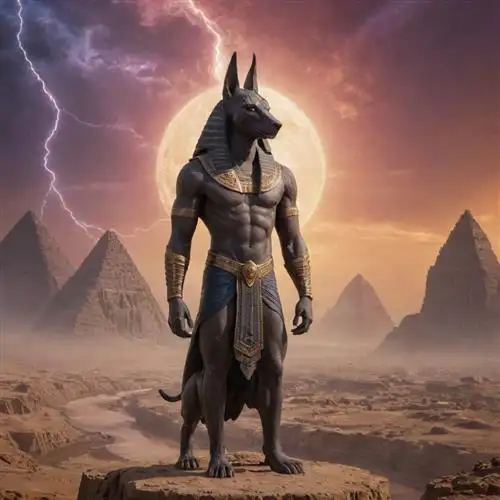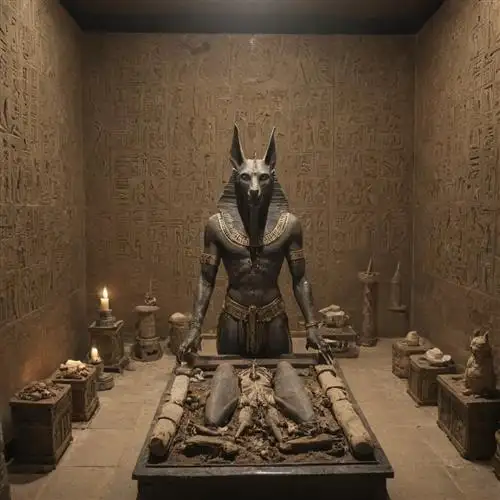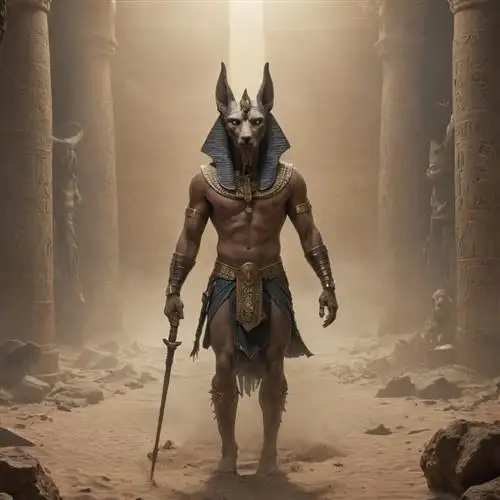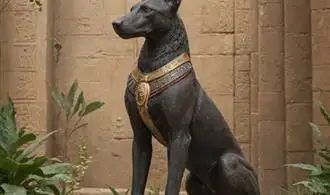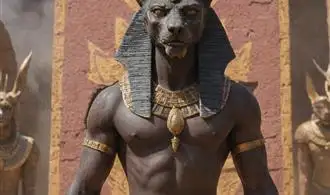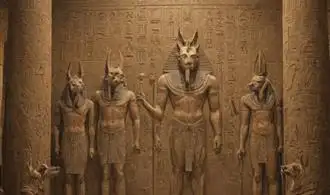
The Role of Anubis in the Afterlife
Anubis, the jackal-headed Egyptian deity, played a pivotal role in the ancient Egyptian conception of the afterlife. As the god of embalming and the protector of the dead, Anubis was responsible for guiding the deceased on their journey through the underworld and ensuring their successful transition into the realm of the afterlife.
One of Anubis' primary duties was the mummification process. He was believed to have taught the art of embalming to the ancient Egyptians, ensuring the preservation of the physical body. This was crucial, as the Egyptians believed the soul could only return to the body after death, necessitating the careful preservation of the corpse.
In the afterlife, Anubis played a central role in the weighing of the heart ceremony, also known as the "Judgment of the Dead." During this ritual, the deceased's heart was weighed against the feather of truth, symbolizing the moral purity of the individual. Anubis would oversee this process, ensuring the accuracy of the judgment and the fair treatment of the departed soul.
If the heart was found to be pure, the soul would be deemed worthy of eternal life in the afterlife. However, if the heart was found to be heavier than the feather, it would be devoured by the monstrous Ammit, the "Devourer of Souls," condemning the individual to eternal oblivion. Anubis' presence and guidance during this critical moment were essential in determining the fate of the deceased.
Moreover, Anubis was believed to be the protector of the dead, guarding the tombs and the mummified remains of the departed. He was often depicted as a jackal or a jackal-headed man, and his presence was invoked in funerary rites and rituals to ensure the safe passage of the soul into the afterlife.
The Weighing of the Heart Ceremony
The Weighing of the Heart Ceremony was a critical ritual in ancient Egyptian beliefs about the afterlife. During this ceremony, the deceased person's heart was weighed against the feather of truth, represented by the goddess Maat. This process determined whether the individual was worthy of entering the afterlife and experiencing eternal bliss.
The ceremony was conducted in the Hall of Judgment, where the deceased stood before the gods, including Anubis, the jackal-headed god associated with mummification and the afterlife. Anubis would place the heart of the deceased on one side of a scale, while the feather of truth was placed on the other. The heart was believed to contain the person's soul, memories, and moral character.
If the heart balanced evenly with the feather, it was considered pure, and the individual was deemed worthy to continue their journey into the afterlife. However, if the heart was heavier, signifying the person's misdeeds or sins, it would be devoured by the monstrous creature Ammit, a composite being with the head of a crocodile, the torso of a lion, and the hindquarters of a hippopotamus.
The successful completion of the Weighing of the Heart Ceremony was crucial for the deceased to achieve the ultimate goal of ancient Egyptian beliefs: the eternal afterlife. The ceremony was a final judgment, a chance for the individual to account for their actions and be granted access to the paradise of the gods.
The ritual was not only important for the individual but also for the stability and order of the entire Egyptian society. By upholding the principle of justice and moral behavior, the Weighing of the Heart Ceremony reinforced the belief that the gods were the ultimate arbiters of right and wrong, and that the afterlife was a reward for those who lived virtuous lives.
Anubis and the Mummification Process
Anubis, the jackal-headed god of ancient Egypt, played a pivotal role in the mummification process, which was an integral part of the journey to the afterlife. As the guardian of the dead and the embalmer of the pharaohs, Anubis oversaw every step of this intricate ritual, ensuring the preservation of the deceased's physical form and the smooth transition to the realm of the gods.
At the heart of the mummification process was the removal of the internal organs, a task that Anubis was believed to perform with the utmost care and precision. The brain was carefully extracted through the nostrils, while the other organs, such as the lungs, liver, stomach, and intestines, were carefully removed and placed in canopic jars, each guarded by a different deity. This meticulous process ensured that the body was prepared to withstand the journey to the afterlife and the final judgment before Osiris, the lord of the underworld.
Anubis also played a crucial role in the wrapping and bandaging of the body, a process that was believed to symbolically reconnect the physical and spiritual aspects of the individual. The wrappings were applied with great care, ensuring that the body was protected and preserved, while also allowing for the free movement of the ka, the vital force that was believed to reside within the individual.
Furthermore, Anubis was responsible for weighing the heart of the deceased against the feather of truth, a pivotal moment in the judgment process. This ritual, known as the "weighing of the heart," determined whether the individual was worthy of entering the afterlife. Anubis, as the guardian of this process, ensured that the scales were balanced and that the judgment was fair and impartial.
The Mythology of Anubis and the Afterlife
The mythology of Anubis and the afterlife is a captivating aspect of ancient Egyptian beliefs. Anubis, the jackal-headed god, played a crucial role in guiding the deceased through the complexities of the afterlife. As the god of embalming and funerals, Anubis was responsible for the mummification process, ensuring the preservation of the physical body for the journey into the next world.
One of the primary responsibilities of Anubis was the weighing of the heart ceremony, where the heart of the deceased was weighed against the feather of Ma'at, the goddess of truth and justice. This ritual determined the fate of the soul, as a heart that was found to be lighter than the feather symbolized a life well-lived, allowing the individual to pass through to the afterlife. Conversely, a heart heavier than the feather would result in the soul being devoured by the devourer, a monstrous creature with the body of a hippopotamus and the head of a crocodile.
In addition to his role in the weighing of the heart, Anubis was also responsible for guiding the deceased through the various challenges and obstacles of the afterlife. The Anubis Predicts the Future of the Afterlife article explores the intricate tapestry of the afterlife, where Anubis served as a protector and navigator for the soul, ensuring a safe passage through the trials and tribulations of the underworld.
The mythology of Anubis and the afterlife is further enriched by the concept of the "Book of the Dead," a collection of spells and incantations believed to aid the deceased in their journey to the afterlife. These spells, which were often inscribed on the walls of tombs or placed within the coffin, were thought to provide the deceased with the necessary knowledge and protection to navigate the hazards of the underworld successfully.
Anubis and the Afterlife in Contemporary Culture
Anubis, the ancient Egyptian god of the dead, has captivated the imaginations of people across the globe for millennia. In the modern era, this enigmatic deity continues to hold a prominent place in popular culture, influencing art, literature, and even our understanding of the afterlife. From blockbuster movies to bestselling novels, Anubis has transcended his ancient roots, evolving into a symbol of the mysteries that lie beyond the veil of death.
One of the most striking ways in which Anubis has made his mark on contemporary culture is through the medium of film. In recent years, the god of the dead has been a recurring figure in big-budget Hollywood productions, often serving as a guide or gatekeeper to the underworld. In the 2017 film "The Mummy," for example, Anubis plays a central role, guarding the entrance to the realm of the dead and ushering the protagonist into a world of supernatural forces. Similarly, in the "Assassin's Creed" video game franchise, Anubis is depicted as a powerful and enigmatic entity, wielding control over the afterlife and the fate of the soul.
Beyond the silver screen, Anubis has also found a home in the world of literature, inspiring authors to delve into the mysteries of the afterlife and the role of the jackal-headed god. In Rick Riordan's "Kane Chronicles" series, for instance, Anubis is portrayed as a complex and multifaceted character, serving as a guide and protector to the living as they navigate the challenges of the underworld. Similarly, in the works of bestselling author Neil Gaiman, Anubis appears as a mysterious and powerful figure, guiding the dead through the realms of the afterlife.
But the influence of Anubis extends beyond the realms of film and literature. In the field of contemporary art, the god of the dead has been a source of inspiration for a wide range of artists, who have used his iconic image to explore themes of mortality, the afterlife, and the mysteries of the human experience. From sculptures and paintings to immersive installations, Anubis has become a powerful symbol of the enduring fascination with the unknown and the unknowable.

